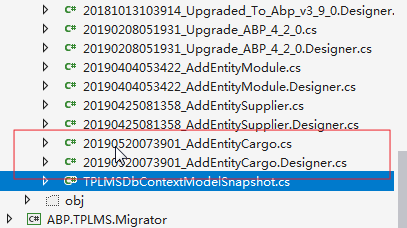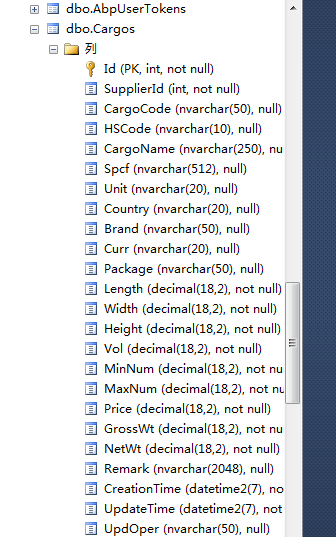abp(net core)+easyui+efcore实现仓储管理系统——EasyUI之货物管理一 (十九)
abp(net core)+easyui+efcore实现仓储管理系统目录
abp(net core)+easyui+efcore实现仓储管理系统——ABP总体介绍(一)
abp(net core)+easyui+efcore实现仓储管理系统——解决方案介绍(二)
abp(net core)+easyui+efcore实现仓储管理系统——领域层创建实体(三)
abp(net core)+easyui+efcore实现仓储管理系统——定义仓储并实现 (四)
abp(net core)+easyui+efcore实现仓储管理系统——创建应用服务(五)
abp(net core)+easyui+efcore实现仓储管理系统——展现层实现增删改查之控制器(六)
abp(net core)+easyui+efcore实现仓储管理系统——展现层实现增删改查之列表视图(七)
abp(net core)+easyui+efcore实现仓储管理系统——展现层实现增删改查之增删改视图(八)
abp(net core)+easyui+efcore实现仓储管理系统——展现层实现增删改查之菜单与测试(九)
abp(net core)+easyui+efcore实现仓储管理系统——多语言(十)
abp(net core)+easyui+efcore实现仓储管理系统——使用 WEBAPI实现CURD (十一)
abp(net core)+easyui+efcore实现仓储管理系统——使用 WEBAPI实现CURD (十二)
abp(net core)+easyui+efcore实现仓储管理系统——使用 WEBAPI实现CURD (十三)
abp(net core)+easyui+efcore实现仓储管理系统——使用 WEBAPI实现CURD (十四)
abp(net core)+easyui+efcore实现仓储管理系统——使用 WEBAPI实现CURD (十五)
abp(net core)+easyui+efcore实现仓储管理系统——菜单-上 (十六)
abp(net core)+easyui+efcore实现仓储管理系统——菜单-下(十七)
abp(net core)+easyui+efcore实现仓储管理系统——EasyUI前端页面框架 (十八)
通过上一篇(abp(net core)+easyui+efcore实现仓储管理系统——EasyUI前端页面框架 (十八))文章,我们已经将EasyUI添加到我们的项目中了。下面我们通过EasyUI做为前端页面的UI控件来展现一个货物信息管理的前端功能,并使用创建相应的实体类,服务类等来实现后台功能。
四、创建Cargo实体
1. 在Visual Studio 2017的“解决方案资源管理器”中,右键单击“ABP.TPLMS.Core”项目的“Entitys”文件夹,在弹出菜单中选择“添加” >
> “类”。 将类命名为 Cargo,然后选择“添加”。
2.创建Cargo类继承自Entity<int>,通过实现审计模块中的IHasCreationTime来实现保存创建时间。代码如下:
using Abp.Domain.Entities;
using Abp.Domain.Entities.Auditing;
using System;
using System.Collections.Generic;
using System.ComponentModel.DataAnnotations;
using System.ComponentModel.DataAnnotations.Schema;
using System.Text; namespace ABP.TPLMS.Entitys
{ public class Cargo : Entity<int>, IHasCreationTime
{ public Cargo()
{ this.Id = ;
this.SupplierId = ;
this.CargoCode = string.Empty;
this.CargoName = string.Empty;
this.Brand = string.Empty;
this.Country = string.Empty;
this.CreationTime = DateTime.Now;
this.Curr = string.Empty; this.GrossWt = ;
this.Height = ;
this.HSCode = string.Empty;
this.Length = ; this.MaxNum = ;
this.MinNum = ;
this.NetWt = ; this.Package = string.Empty;
this.Price = ;
this.Remark = string.Empty; this.Spcf = string.Empty;
this.Unit = string.Empty;
this.UpdateTime = DateTime.Now; this.UpdOper = string.Empty;
this.Vol = ;
this.Width = ; } public int SupplierId { get; set; }
[StringLength()]
public string CargoCode { get; set; }
[StringLength()]
public string HSCode { get; set; } [StringLength()]
public string CargoName { get; set; } [StringLength()]
public string Spcf { get; set; }
public string Unit { get; set; } public string Country { get; set; }
public string Brand { get; set; } public string Curr { get; set; }
public string Package { get; set; }
public decimal Length { get; set; } public decimal Width { get; set; }
public decimal Height { get; set; }
public decimal Vol { get; set; } public decimal MinNum { get; set; }
public decimal MaxNum { get; set; } public decimal Price { get; set; }
public decimal GrossWt { get; set; } public decimal NetWt { get; set; }
public string Remark { get; set; } public DateTime CreationTime { get; set; }
public DateTime UpdateTime { get; set; }
public string UpdOper { get; set; } } }
3.定义好实体之后,我们去“ABP.TPLMS.EntityFrameworkCore”项目中的“TPLMSDbContext”类中定义实体对应的DbSet,以应用Code First 数据迁移。添加以下代码
using Microsoft.EntityFrameworkCore;
using Abp.Zero.EntityFrameworkCore;
using ABP.TPLMS.Authorization.Roles;
using ABP.TPLMS.Authorization.Users;
using ABP.TPLMS.MultiTenancy; using ABP.TPLMS.Entitys; namespace ABP.TPLMS.EntityFrameworkCore
{
public class TPLMSDbContext : AbpZeroDbContext<Tenant, Role, User, TPLMSDbContext>
{ /* Define a DbSet for each entity of the application */ public TPLMSDbContext(DbContextOptions<TPLMSDbContext> options)
: base(options)
{
} public DbSet<Module> Modules { get; set; }
public DbSet<Supplier> Suppliers { get; set; }
public DbSet<Cargo> Cargos { get; set; } }
}
4.从菜单中选择“工具->NuGet包管理器器—>程序包管理器控制台”菜单。
5. 在PMC中,默认项目选择EntityframeworkCore对应的项目后。输入以下命令:Add-Migration AddEntityCargo,创建迁移。
6. 在上面的命令执行完毕之后,创建成功后,会在Migrations文件夹下创建时间_AddEntityCargo格式的类文件,这些代码是基于DbContext指定的模型。如下图。

7.在程序包管理器控制台,输入Update-Database,回车执行迁移。执行成功后,如下图。

8. 在SQL Server Management Studio中查看数据库,Cargos表创建成功。

五、定义应用服务接口需要用到的分页类
为了在进行查询时使用, PagedCargoResultRequestDto被用来将货物查询条件的数据传递到给应用层.
1. 在Visual Studio 2017的“解决方案资源管理器”中,右键单击“ABP.TPLMS.Application”项目,在弹出菜单中选择“添加” > “新建文件夹”,并重命名为“Cargos”
2. 使用鼠标右键单击我们刚才创建的“Cargos”文件夹,在弹出菜单中选择“添加” > “新建文件夹”,并重命名为“Dto”。
3.右键单击“Dto”文件夹,然后选择“添加” > “类”。 将类命名为 Paged CargoResultRequestDto,然后选择“添加”。代码如下。
using Abp.Application.Services.Dto;
using System;
using System.Collections.Generic;
using System.Text; namespace ABP.TPLMS.Cargos.Dto
{
public class PagedCargoResultRequestDto : PagedResultRequestDto
{ public string Keyword { get; set; }
}
}
4.右键单击“Dto”文件夹,然后选择“添加” > “类”。 将类命名为 CargoDto,然后选择“添加”。代码如下。
using Abp.Application.Services.Dto;
using Abp.AutoMapper;
using ABP.TPLMS.Entitys;
using System;
using System.Collections.Generic;
using System.Text; namespace ABP.TPLMS.Cargos.Dto
{ [AutoMapFrom(typeof(Cargo))]
public class CargoDto:EntityDto<int>
{ public int SupplierId { get; set; }
public string CargoCode { get; set; }
public string HSCode { get; set; } public string CargoName { get; set; } public string Spcf { get; set; }
public string Unit { get; set; }
public string Country { get; set; } public string Brand { get; set; } public string Curr { get; set; }
public string Package { get; set; }
public decimal Length { get; set; }
public decimal Width { get; set; } public decimal Height { get; set; }
public decimal Vol { get; set; } public decimal MinNum { get; set; }
public decimal MaxNum { get; set; }
public decimal Price { get; set; }
public decimal GrossWt { get; set; } public decimal NetWt { get; set; } public string Remark { get; set; }
public DateTime CreationTime { get; set; } public DateTime UpdateTime { get; set; }
public string UpdOper { get; set; } }
}
5.右键单击“Dto”文件夹,然后选择“添加” > “类”。 将类命名为 CreateUpdateCargoDto,然后选择“添加”。代码如下。
using Abp.Application.Services.Dto;
using Abp.AutoMapper;
using ABP.TPLMS.Entitys;
using System;
using System.Collections.Generic;
using System.ComponentModel.DataAnnotations;
using System.Text; namespace ABP.TPLMS.Cargos.Dto
{ [AutoMapTo(typeof(Cargo))]
public class CreateUpdateCargoDto : EntityDto<int>
{ public int SupplierId { get; set; }
[StringLength()]
public string CargoCode { get; set; } [StringLength()]
public string HSCode { get; set; } [StringLength()]
public string CargoName { get; set; } [StringLength()]
public string Spcf { get; set; } [StringLength()]
public string Unit { get; set; }
[StringLength()]
public string Country { get; set; } [StringLength()]
public string Brand { get; set; } [StringLength()]
public string Curr { get; set; } [StringLength()]
public string Package { get; set; } public decimal Length { get; set; }
public decimal Width { get; set; }
public decimal Height { get; set; }
public decimal Vol { get; set; } public decimal MinNum { get; set; }
public decimal MaxNum { get; set; }
public decimal Price { get; set; }
public decimal GrossWt { get; set; }
public decimal NetWt { get; set; }
[StringLength()]
public string Remark { get; set; }
public DateTime CreationTime { get; set; } public DateTime UpdateTime { get; set; }
[StringLength()]
public string UpdOper { get; set; }
}
}
abp(net core)+easyui+efcore实现仓储管理系统——EasyUI之货物管理一 (十九)的更多相关文章
- abp(net core)+easyui+efcore实现仓储管理系统——EasyUI之货物管理二 (二十)
abp(net core)+easyui+efcore实现仓储管理系统目录 abp(net core)+easyui+efcore实现仓储管理系统——ABP总体介绍(一) abp(net core)+ ...
- abp(net core)+easyui+efcore实现仓储管理系统——EasyUI之货物管理三 (二十一)
abp(net core)+easyui+efcore实现仓储管理系统目录 abp(net core)+easyui+efcore实现仓储管理系统——ABP总体介绍(一) abp(net core)+ ...
- abp(net core)+easyui+efcore实现仓储管理系统——EasyUI之货物管理四 (二十二)
abp(net core)+easyui+efcore实现仓储管理系统目录 abp(net core)+easyui+efcore实现仓储管理系统——ABP总体介绍(一) abp(net core)+ ...
- abp(net core)+easyui+efcore实现仓储管理系统——EasyUI之货物管理五 (二十三)
abp(net core)+easyui+efcore实现仓储管理系统目录 abp(net core)+easyui+efcore实现仓储管理系统——ABP总体介绍(一) abp(net core)+ ...
- abp(net core)+easyui+efcore实现仓储管理系统——EasyUI之货物管理六(二十四)
abp(net core)+easyui+efcore实现仓储管理系统目录 abp(net core)+easyui+efcore实现仓储管理系统——ABP总体介绍(一) abp(net core)+ ...
- abp(net core)+easyui+efcore实现仓储管理系统——EasyUI之货物管理七(二十五)
abp(net core)+easyui+efcore实现仓储管理系统目录 abp(net core)+easyui+efcore实现仓储管理系统——ABP总体介绍(一) abp(net core)+ ...
- abp(net core)+easyui+efcore实现仓储管理系统——EasyUI之货物管理八(二十六)
abp(net core)+easyui+efcore实现仓储管理系统目录 abp(net core)+easyui+efcore实现仓储管理系统——ABP总体介绍(一) abp(net core)+ ...
- abp(net core)+easyui+efcore实现仓储管理系统——出库管理之二(五十)
abp(net core)+easyui+efcore实现仓储管理系统目录 abp(net core)+easyui+efcore实现仓储管理系统--ABP总体介绍(一) abp(net core)+ ...
- abp(net core)+easyui+efcore实现仓储管理系统——EasyUI前端页面框架 (十八)
目录 abp(net core)+easyui+efcore实现仓储管理系统——ABP总体介绍(一) abp(net core)+easyui+efcore实现仓储管理系统——解决方案介绍(二) ab ...
随机推荐
- Mac 打造开发工作环境
近日公司配的dell笔记本越来越难担重任(主要是CPU太差,本人是Java开发,IDE一编译CPU就100%),于是狠下心入手了一台常规顶配Macbook Pro,现记录新本本的调教过程. Homeb ...
- ajax中的后台返回数据data的意义
- Java并发编程——线程池的使用
在前面的文章中,我们使用线程的时候就去创建一个线程,这样实现起来非常简便,但是就会有一个问题: 如果并发的线程数量很多,并且每个线程都是执行一个时间很短的任务就结束了,这样频繁创建线程就会大大降低系统 ...
- ElasticSearch专栏
1.es的分布式架构原理(es是如何实现分布式)? elasticsearch设计的理念就是分布式搜索引擎,底层其实还是基于lucene的.核心思想就是在多台机器上启动多个es进程实例,组成了一个es ...
- JavaScript入门之AJAX:原生ajax
背景 传统的Web应用允许用户端填写表单(form),当提交表单时就向网页服务器发送一个请求.服务器接收并处理传来的表单,然后送回一个新的网页,但这个做法浪费了许多带宽,因为在前后两个页面中的大部分H ...
- vue.js如何根据后台返回来的图片url进行图片下载
最近在做一个前端vue.js对接的功能模块时,需要实现一个下载图片的功能,后台返回来的是一串图片url,试了很多种方法,发现点击下载时出来的效果都是跳着到一个新的图片网页,后来经过一番琢磨,终于解决了 ...
- 洛谷P1273 有线电视网 树上分组背包DP
P1273 有线电视网 )逼着自己写DP 题意:在一棵树上选出最多的叶子节点,使得叶子节点的值 减去 各个叶子节点到根节点的消耗 >= 0: 思路: 树上分组背包DP,设dp[u][k] 表示 ...
- 2019 Multi-University Training Contest 3
B.Blow up the city solved by F0_0H 210min 题意 给一个DAG,每次询问给定u,v,求使得u或v不能与中心点联通的关键点个数 做法 按照拓扑序建树 新加节点的父 ...
- Aizu-2249 Road Construction(dijkstra求最短路)
Aizu - 2249 题意:国王本来有一个铺路计划,后来发现太贵了,决定删除计划中的某些边,但是有2个原则,1:所有的城市必须能达到. 2:城市与首都(1号城市)之间的最小距离不能变大. 并且在这2 ...
- Codeforces Round #481 (Div. 3) B. File Name
题目地址:http://codeforces.com/contest/978/problem/B 题解:一串文件名里不能出现连续的xxx,询问进行几次操作后,文件名才不会出现xxx. 方法:只要遍历一 ...
